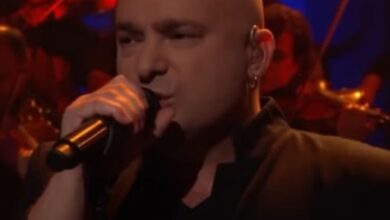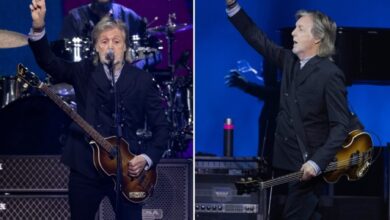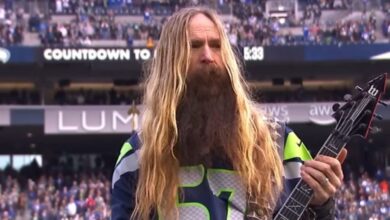Metallica’s ‘Blackened’ Engulfs Levi’s Stadium in Flame and Fury, June 22 2025
During Metallica’s incendiary performance of “Blackened” in Santa Clara on June 22 2025, James Hetfield’s serrated growl, Kirk Hammett’s wah-soaked leads, and Lars Ulrich’s machine-gun double-kick fused into a sonic firestorm that rolled across Levi’s Stadium like a summer wildfire. More than fifty-thousand voices rose in unison as the opening riff dropped, turning a simple Sunday night into a communal rite of catharsis and noise.
For hometown fans, the moment felt almost mythic. Metallica’s Bay Area roots stretch back to scrappy club gigs at the Old Waldorf and Ruthie’s Inn, yet here they were—decades later—commanding an NFL arena with the same ferocity that once rattled bar-room rafters. The M72 “No Repeat Weekend” concept promised surprises, but few expected the band to unleash one of its most technically punishing songs with such swagger and ease.
“Blackened” first detonated on 1988’s …And Justice for All, co-written by Hetfield and then-bassist Jason Newsted. Conceived in the shadow of the Cold War, its apocalyptic imagery of scorched skies and poisoned earth struck listeners as prophetic; in 2025, amid climate anxiety and geopolitical tension, its warnings felt chillingly current and electrified the stadium long before the first pyrotechnic burst.
The Levi’s rendition showcased the band’s circular “in-the-round” stage—the so-called “pizza” design—allowing Hetfield and Hammett to stalk multiple runways while Robert Trujillo roamed the central ring with spider-fingered bass lines. Eight towering video columns broadcast sweat-beaded close-ups so even the fans in the top tiers caught every string bend and cymbal crash in cinematic clarity.
As Ulrich counted in the rapid-fire main riff, the stage erupted in synchronized flame jets, their orange glare mirrored by thousands of cell-phone screens. The heat was palpable fifty rows deep; veteran concertgoers recalled the notorious 1992 Oakland Coliseum “Fuel” inferno, yet modern technology kept temperatures thrilling rather than dangerous, underscoring how far stadium production has evolved.
Trujillo’s bass tone—thick, growling, and unmistakably present—offered poetic justice to fans who still lament the near-inaudible low end on the original Justice mix. Each slap and slide rumbled through the subwoofers, giving the song a heft it never fully enjoyed on vinyl. When he locked eyes with Hetfield during the stop-start breakdown, their grin spoke volumes about brotherhood and resurrection.
Vocally, Hetfield balanced grit and stamina with surprising nuance. At sixty-one, he altered phrasing just enough to preserve his voice without dulling its edge, elongating “termination” and letting the crowd finish the line. The call-and-response echoed his recovery journey after a 2019 rehab stint—proof that self-care can coexist with raw aggression.
Hammett’s solo, long critiqued for its shred-heavy excess on the album, felt refreshed in 2025. Instead of a note-for-note recital, he threaded new blues bends between the original chromatic runs, winking at Snake Pit fans as he kicked his purple ESP into overdrive. The spontaneity harked back to the free-form jams of the 1991-93 Wherever We May Roam tour.
Levi’s Stadium itself seemed to breathe with the music. Engineers synced spotlights to Ulrich’s hi-hat, bathing the audience in stark whites during halftime passages, then plunging them into ultraviolet gloom for the whispered “see our mother die” section. It was theatrical without feeling contrived—an artful evolution of the minimalist lighting that once defined the Justice set.
Between verses, Hetfield saluted the local faithful: “Forty-two years ago we started this in a garage across the Bay. Tonight we celebrate you—our family of misfits!” The resulting roar rivaled San Francisco’s 2010 World Series parade, confirming that Metallica’s hometown bond remains unbreakable, no matter how global their reach.
“Blackened” bridged generational gaps in the stands. Teenagers in 72 Seasons merch head-banged beside parents who bought Kill ’Em All on cassette. That shared rush mirrored earlier Bay Area milestones—like the 2003 Fillmore anniversary gigs—proving these thrash pioneers still connect eras and identities through sheer volume and conviction.
Historically, the song has served as both opener and encore, but placing it mid-set created a momentum jolt that rippled through everything that followed. The bruising segue into “Whiskey in the Jar” highlighted Metallica’s stylistic range: apocalyptic fury one moment, Celtic revelry the next. Only a catalog this deep can swing so wildly without losing coherence.
The track’s ecological warning felt especially pointed beneath California’s drought-stressed skies. Giant LED screens flashed cracked earth and swirling ash during the bridge, subtly updating Cold War dread for today’s climate crisis. Fans later dubbed it “metal’s TED Talk”—urgent, visceral, impossible to ignore.
As the final chord echoed and the flames retreated, Hetfield raised a fist, mouthing thanks while Ulrich launched drumsticks into the pit. The crowd—ears ringing, throats raw—answered with chants of “Bay Area, Bay Area,” echoing old Raiders rituals and sealing the evening’s communal triumph.
Social feeds soon overflowed with clips captioned “Blackened 2025 > Blackened ’88,” a hyperbolic yet telling sentiment. Decades after its birth, the song remains a living organism—evolving through new technologies, new crises, and new waves of fans. On this June evening, nostalgia didn’t rule Levi’s Stadium; instead, Metallica’s darkest anthem burned brightest in the here and now.
By night’s end, a cool coastal breeze drifted over the crowd, carrying the lingering riff into the starry sky. In a career defined by towering originals, this ferocious staple proved once again that great songs—and great bands—never stop evolving, only blazing forward in ever-brighter arcs.





